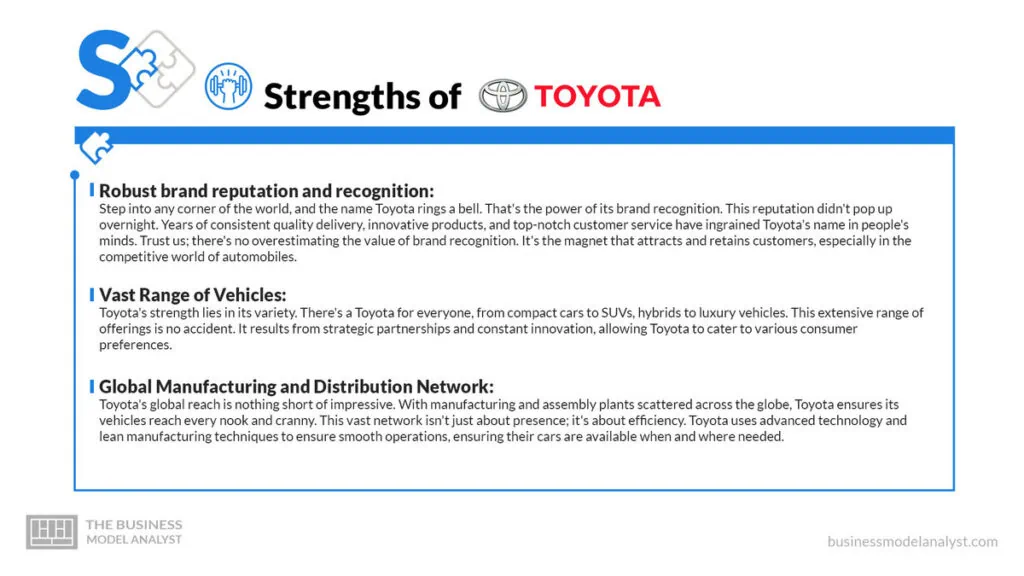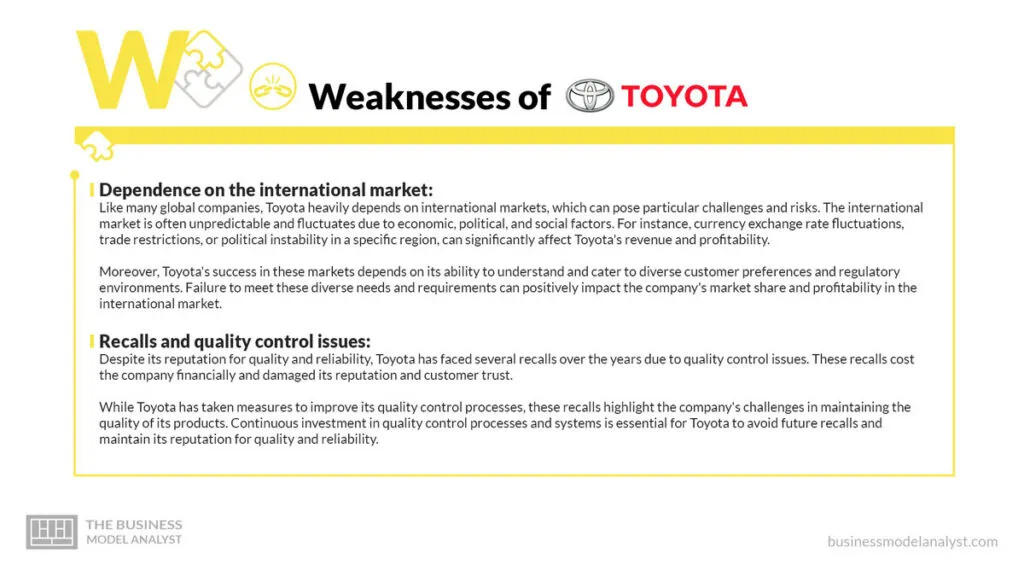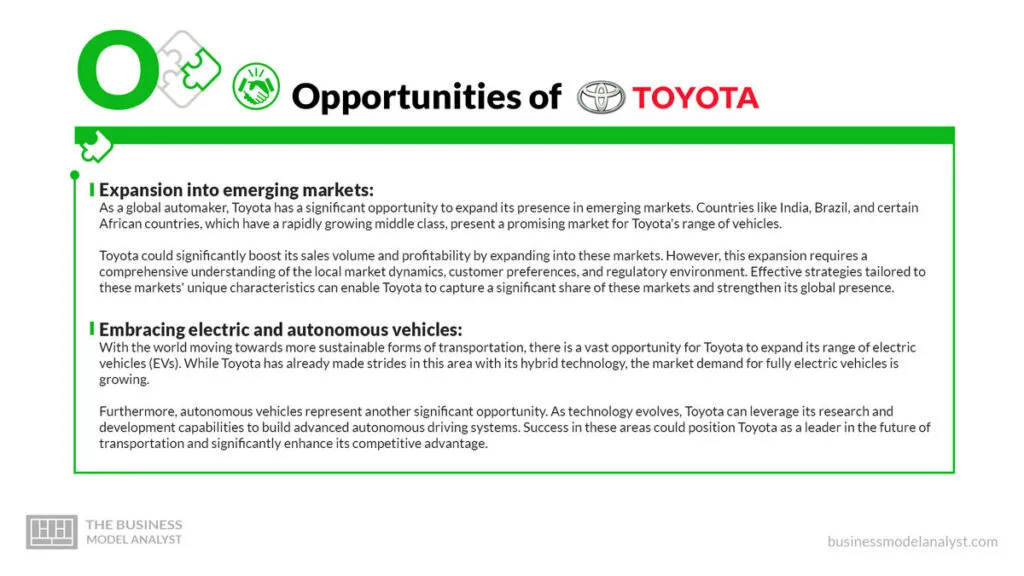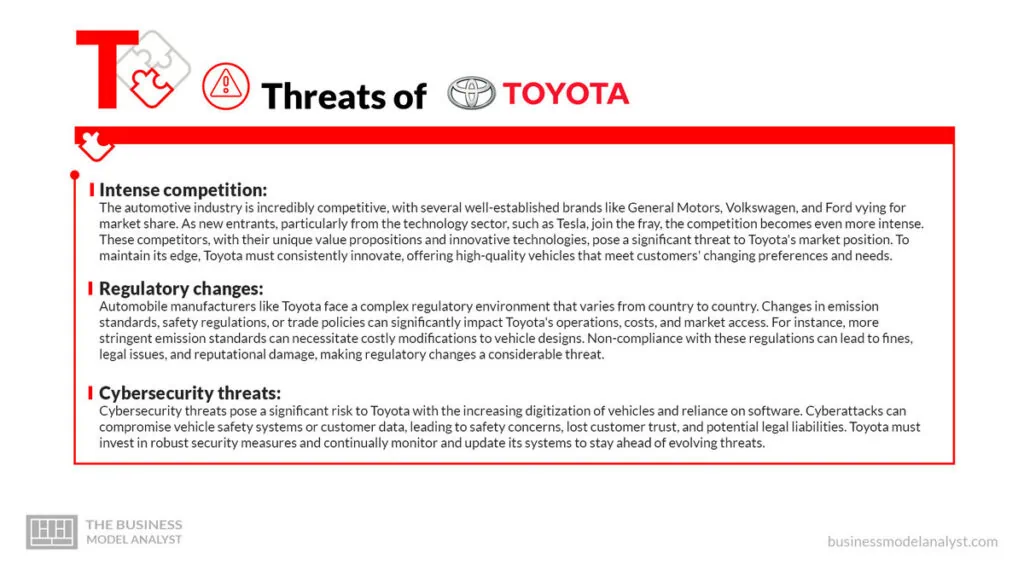Toyota, known worldwide, is a big shot in the automobile industry. The company has been around since 1937, growing from a small entity to an industry titan. Today, Toyota isn’t just a name; it’s a brand representing quality, reliability, and value for money. With operations spanning the globe, Toyota’s influence in the automotive sector is undeniable. But understanding Toyota’s SWOT analysis isn’t just about knowing its reputation. It’s about digging deep to uncover what’s beneath the surface.
Like any other business, Toyota has its strengths and weaknesses, opportunities, and threats. No business is unbeatable, and a SWOT analysis is just the tool we need to uncover these factors. It’s a deep dive into the company’s internal and external environments, shedding light on the positive and negative aspects.
So whether you’re an entrepreneur looking to learn from Toyota’s journey, an investor interested in its stock, or simply a curious reader, this Toyota SWOT analysis is for you. It aims to provide a detailed understanding of Toyota’s strengths and weaknesses and how these could play out against opportunities and threats in the future.
Contents
Toyota Strengths

- Robust brand reputation and recognition
Step into any corner of the world, and the name Toyota rings a bell. That’s the power of its brand recognition. This reputation didn’t pop up overnight. Years of consistent quality delivery, innovative products, and top-notch customer service have ingrained Toyota’s name in people’s minds. Trust us; there’s no overestimating the value of brand recognition. It’s the magnet that attracts and retains customers, especially in the competitive world of automobiles.
- Vast Range of Vehicles
Toyota’s strength lies in its variety. There’s a Toyota for everyone, from compact cars to SUVs, hybrids to luxury vehicles. This extensive range of offerings is no accident. It results from strategic partnerships and constant innovation, allowing Toyota to cater to various consumer preferences.
- Global Manufacturing and Distribution Network
Toyota’s global reach is nothing short of impressive. With manufacturing and assembly plants scattered across the globe, Toyota ensures its vehicles reach every nook and cranny. This vast network isn’t just about presence; it’s about efficiency. Toyota uses advanced technology and lean manufacturing techniques to ensure smooth operations, ensuring their cars are available when and where needed.
- Cutting-Edge Technology
Toyota is a tech-savvy player. It extensively uses artificial intelligence, data analytics, and other advanced technologies to improve its operations and customer experience. Toyota is always at the forefront of automotive technology, from developing hybrid vehicles to implementing autonomous driving features.
- Impressive Financial Health
Toyota’s financial performance is a testament to its strength. Consistent revenue growth, high-profit margins, and a healthy balance sheet make Toyota financially robust. This financial strength gives Toyota the freedom to invest in new projects, innovate, and weather economic downturns.
- Loyal Customer Base
Toyota’s customer base is vast and diverse. The extensive range of vehicles and a strong brand reputation have helped Toyota attract and retain customers from different demographics and regions. This loyal customer base is one of the main pillars of Toyota’s success.
- Broad Range of Services
Toyota isn’t just about cars. It has successfully diversified into other related services like financial services, marine, and even robotics. This broad range of services allows Toyota to have multiple revenue streams, reducing dependency on vehicle sales alone.
- Successful Partnerships
Toyota’s success isn’t a solo journey. It’s the result of numerous partnerships and collaborations. Toyota’s partnerships have played a vital role in its growth and diversification, from partnering with other automakers for technology sharing to collaborating with tech companies for digital transformation.
- Strong Global Presence
Toyota’s footprint is truly global. Its vehicles are sold in over 170 countries, and it operates manufacturing and assembly plants in multiple regions. This global presence allows Toyota to cater to local markets effectively and insulates it from region-specific downturns.
Toyota Weaknesses

- Dependence on the international market
Like many global companies, Toyota heavily depends on international markets, which can pose particular challenges and risks. The international market is often unpredictable and fluctuates due to economic, political, and social factors. For instance, currency exchange rate fluctuations, trade restrictions, or political instability in a specific region, can significantly affect Toyota’s revenue and profitability.
Moreover, Toyota’s success in these markets depends on its ability to understand and cater to diverse customer preferences and regulatory environments. Failure to meet these diverse needs and requirements can positively impact the company’s market share and profitability in the international market.
- Recalls and quality control issues.
Despite its reputation for quality and reliability, Toyota has faced several recalls over the years due to quality control issues. These recalls cost the company financially and damaged its reputation and customer trust.
While Toyota has taken measures to improve its quality control processes, these recalls highlight the company’s challenges in maintaining the quality of its products. Continuous investment in quality control processes and systems is essential for Toyota to avoid future recalls and maintain its reputation for quality and reliability.
- Dependence on specific suppliers
Toyota operates on a Just-In-Time (JIT) inventory system, which means it depends heavily on its suppliers to deliver parts on time for manufacturing. While this system reduces inventory costs, it also exposes the company to risks associated with supplier performance.
Any delay or disruption in the supply chain, whether due to natural disasters, labor issues, or quality control problems, can disrupt Toyota’s production process, leading to potential delays in product delivery and lost sales. Therefore, managing supplier relationships and mitigating supply chain risks is crucial for Toyota’s operations.
- High production costs
Toyota’s high production costs, particularly in Japan, where labor costs are high, can be a significant weakness. These high costs can make it difficult for Toyota to compete on price with companies that have lower production costs.
Moreover, as the company is committed to producing high-quality vehicles, any attempts to reduce production costs must not compromise the quality of its products. Finding ways to reduce production costs while maintaining product quality is a key challenge for Toyota.
- Regulatory and environmental challenges
Like all automakers, Toyota faces regulatory challenges in the markets in which it operates. These challenges include meeting environmental regulations, safety standards, and other regulatory requirements. Failure to comply with these regulations can result in fines, sanctions, and damage to the company’s reputation.
Furthermore, as environmental concerns become more prominent, Toyota faces pressure to develop more environmentally friendly vehicles. While the company has made strides in this area with its hybrid and electric vehicles, it still lags behind some competitors in the electric vehicle market. Increasing its efforts in developing and promoting environmentally friendly vehicles is crucial for Toyota to meet regulatory requirements and customer expectations.
- Intense competition
The automotive industry is highly competitive, with numerous well-established companies vying for market share. This intense competition can make it difficult for Toyota to maintain its market position and profitability.
In addition to traditional automakers, Toyota faces competition from new entrants in the automotive industry, including technology companies developing autonomous and electric vehicles. Keeping up with these new competitors and staying ahead of technological advancements is a significant challenge for Toyota.
- Slow to adopt new technology.
While Toyota has a reputation for reliability and quality, it has been relatively slow to adopt new technologies compared to some competitors. For example, while other companies have been quick to invest in electric vehicle technology, Toyota has been slower to shift its focus away from its successful hybrid technology.
This slow adoption of new technologies can be a weakness for Toyota, as it can make it harder for the company to compete with companies that are more innovative and quicker to adopt new technologies.
Toyota Opportunities

- Expansion into emerging markets
As a global automaker, Toyota has a significant opportunity to expand its presence in emerging markets. Countries like India, Brazil, and certain African countries, which have a rapidly growing middle class, present a promising market for Toyota’s range of vehicles.
Toyota could significantly boost its sales volume and profitability by expanding into these markets. However, this expansion requires a comprehensive understanding of the local market dynamics, customer preferences, and regulatory environment. Effective strategies tailored to these markets’ unique characteristics can enable Toyota to capture a significant share of these markets and strengthen its global presence.
- Embracing electric and autonomous vehicles
With the world moving towards more sustainable forms of transportation, there is a vast opportunity for Toyota to expand its range of electric vehicles (EVs). While Toyota has already made strides in this area with its hybrid technology, the market demand for fully electric vehicles is growing.
Furthermore, autonomous vehicles represent another significant opportunity. As technology evolves, Toyota can leverage its research and development capabilities to build advanced autonomous driving systems. Success in these areas could position Toyota as a leader in the future of transportation and significantly enhance its competitive advantage.
- Expanding services in the shared mobility space
The shared mobility market, which includes services like ride-hailing and car-sharing, presents a lucrative opportunity for Toyota. As urban populations grow and environmental concerns increase, consumers opt for shared mobility services over vehicle ownership.
By developing and expanding services in this space, Toyota can diversify its revenue streams and cater to changing consumer preferences. Strategies could include partnering with existing shared mobility service providers or developing proprietary services.
- Leveraging digital transformation
Digital transformation allows Toyota to improve its operational efficiency, customer experience, and product innovation. Toyota can enhance its manufacturing processes, predictive maintenance, supply chain management, and customer service by investing in technologies like artificial intelligence, machine learning, and data analytics.
Digital transformation can also enable Toyota to develop more personalized and connected in-car experiences for customers, thus creating a unique value proposition and enhancing customer loyalty.
- Fostering strategic partnerships and alliances
Strategic partnerships and alliances can allow Toyota to expand its technological capabilities, market reach, and product offerings. By collaborating with tech companies, Toyota can accelerate its development of electric and autonomous vehicles, connected car technologies, and other innovative solutions.
Partnerships with local companies in emerging markets can also help Toyota navigate these markets more effectively by leveraging the local companies’ knowledge and networks. These partnerships and alliances can boost Toyota’s competitiveness and growth potential in the rapidly evolving automotive industry.
- Investment in renewable energy solutions
As society becomes more environmentally conscious, there is an increasing demand for renewable energy solutions. This presents an opportunity for Toyota to invest in renewable energy technologies for its operations and products.
For instance, Toyota can invest in renewable energy sources to power its manufacturing facilities, reducing its environmental footprint and operational costs. Moreover, it can develop vehicles powered by alternative energy sources, such as hydrogen fuel cells, further enhancing its reputation as an environmentally friendly automaker.
- More acquisitions
Acquiring businesses that align with Toyota’s strategic objectives can present an opportunity to expand its capabilities, reach, and product offerings. Acquisitions in areas such as electric vehicle technology, autonomous driving technology, and digital transformation can help Toyota stay ahead of the curve in these fast-growing sectors.
Acquisitions can also provide Toyota with access to new markets, customers, and technologies, driving growth and enhancing its competitive positioning. However, assessing potential acquisition targets is essential to ensuring alignment with Toyota’s strategic objectives and realizing the potential benefits.
Toyota Threats

- Intense competition
The automotive industry is incredibly competitive, with several well-established brands like General Motors, Volkswagen, and Ford vying for market share. As new entrants, particularly from the technology sector, such as Tesla, join the fray, the competition becomes even more intense. These competitors, with their unique value propositions and innovative technologies, pose a significant threat to Toyota’s market position. To maintain its edge, Toyota must consistently innovate, offering high-quality vehicles that meet customers’ changing preferences and needs.
- Regulatory changes
Automobile manufacturers like Toyota face a complex regulatory environment that varies from country to country. Changes in emission standards, safety regulations, or trade policies can significantly impact Toyota’s operations, costs, and market access. For instance, more stringent emission standards can necessitate costly modifications to vehicle designs. Non-compliance with these regulations can lead to fines, legal issues, and reputational damage, making regulatory changes a considerable threat.
- Cybersecurity threats
Cybersecurity threats pose a significant risk to Toyota with the increasing digitization of vehicles and reliance on software. Cyberattacks can compromise vehicle safety systems or customer data, leading to safety concerns, lost customer trust, and potential legal liabilities. Toyota must invest in robust security measures and continually monitor and update its systems to stay ahead of evolving threats.
- Economic downturns
Economic downturns can significantly impact Toyota’s sales and profitability. In times of economic uncertainty, consumers often delay purchasing new vehicles or opt for cheaper alternatives. This reduced demand can significantly impact Toyota’s sales, revenues, and profitability. Furthermore, economic downturns can exacerbate competitive pressures as automakers strive to maintain their market share, adding to the challenge.
- Supply chain disruptions
Toyota, like other automakers, relies on a complex global supply chain. Disruptions to this supply chain due to natural disasters, geopolitical issues, or other unexpected events can seriously impact Toyota’s operations. For example, a natural disaster in a region where a critical component is manufactured can delay production, leading to missed sales opportunities and customer dissatisfaction. To mitigate this threat, Toyota must ensure a resilient supply chain with contingency plans to handle potential disruptions.
- Technological disruptions
Rapid technological advancements in the automotive industry, such as electric vehicles, autonomous driving, and connected car technologies, threaten traditional automakers like Toyota. If Toyota fails to keep pace with these developments, it risks losing market share to more innovative competitors. These disruptive technologies require significant investment in research and development and may necessitate changes to Toyota’s business model and strategy.
- Shifts in consumer preferences
Changes in consumer preferences pose another significant threat to Toyota. Today’s consumers are increasingly concerned about environmental sustainability, leading to growing demand for electric and hybrid vehicles. They also value connectivity and digital features in their vehicles. If Toyota fails to anticipate and respond to these shifts in consumer preferences, it may struggle to retain its customers and attract new ones, impacting its market position and profitability.
Conclusion
Toyota is an established leader in the automotive industry with its diverse product lineup, strong global presence, and reputation for quality and reliability. Nevertheless, the company confronts some challenges, including intense competition, regulatory changes, and shifts in consumer preferences. The SWOT analysis of Toyota underscores the company’s strong position in the global auto market, but also underlines the necessity for continuous strategic planning to address its weaknesses and threats.
Toyota’s success in the future will hinge on its ability to build on its strengths, address its weaknesses, seize opportunities, and mitigate the threats it faces. With its strong brand, history of innovation, and commitment to quality, Toyota is well-positioned to navigate these challenges and opportunities in the evolving automotive landscape.


